Building Oyster Habitats
Citizens, school and youth groups, and other interested parties are invited to assist South Carolina Department of Natural Resources (SCDNR) staff in building oyster habitats along the South Carolina coast. The habitats built under the SCORE program will be relatively small, but they will allow SCDNR to conduct experiments to refine restoration techniques before embarking on large-scale restoration projects.
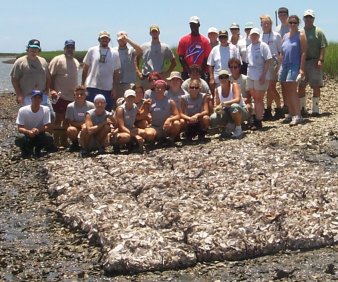 All reef construction must be supervised by SCDNR. SCDNR has obtained a permit from the South Carolina Department of Health and Environmental Control for our volunteers to conduct this restoration. Citizens cannot conduct restoration on their own initiative, so please fill out the volunteer form if you are interested in participating in this exciting oyster restoration project!
All reef construction must be supervised by SCDNR. SCDNR has obtained a permit from the South Carolina Department of Health and Environmental Control for our volunteers to conduct this restoration. Citizens cannot conduct restoration on their own initiative, so please fill out the volunteer form if you are interested in participating in this exciting oyster restoration project!
The process of reef construction can be divided into four steps:
Site Selection
SCDNR must make the final decision on choosing sites for all the reefs, but citizens are welcome to make suggestions of potentially suitable areas. Factors which are considered in selecting a site include the following:
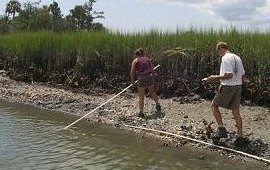 Evidence of current or past oyster habitat
Evidence of current or past oyster habitat - Salinity and flow appropriate for sustaining oyster growth
- Substrate (soft mud is not suitable)
- Slope (steep slopes are difficult)
- Accessibility (preferably by land)
- Need for stabilization of shoreline (ongoing erosion)
- Availability of historical data
- Availability of citizen volunteers to build and later monitor
- Potential for human disturbance
Shell Procurement
Oyster habitats are created by replanting shell (primarily oyster shell but also whelk and clam shell in appropriate intertidal locations. Shell used for habitat restoration and enhancement must be properly aged. There are several reasons for this:
- Raw shell may be a health hazard.
- Smelly shell attracts insects (particularly gnats) making the handling process unpleasant.
- Shells (particularly shells from other states) may harbor parasites or pathogens that could harm local oysters; aging assures that these pathogens have been destroyed.
Research to determine the minimum aging time is being conducted at this time. Until a definitive answer is available, SCDNR is recommending a 6-month aging period.
In order to create a supply of aged shell for use in this and other restoration projects, SCDNR is encouraging the public to recycle oyster shells and bring them to regional centers for stockpiling. This allows SCDNR to manage the shell and assure that it is not used until properly aged. Additional shell is purchased by SCDNR from shucking houses. As the shell recycling program expands we hope to reduce the need to purchase shell.
Bag Filling
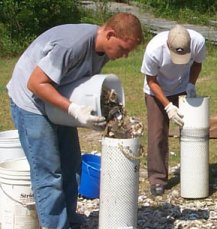 Community-built reefs are constructed of plastic mesh bags filled with oyster shell. The mesh bag creates a stable, three-dimensional habitat that is conducive to recruitment of juvenile oysters. The mesh bags are laid side-by-side on the shore to create a "footprint" which will eventually become a living oyster reef. Some shell bags will be used as "stump bags" with rebar pushed through them and placed standing upright at the reefs. The vertical orientation of the stump bags exposes less surface areas to siltation but more to juvenile oysters.
Community-built reefs are constructed of plastic mesh bags filled with oyster shell. The mesh bag creates a stable, three-dimensional habitat that is conducive to recruitment of juvenile oysters. The mesh bags are laid side-by-side on the shore to create a "footprint" which will eventually become a living oyster reef. Some shell bags will be used as "stump bags" with rebar pushed through them and placed standing upright at the reefs. The vertical orientation of the stump bags exposes less surface areas to siltation but more to juvenile oysters.
Each reef is constructed of approximately 100 shell bags and most sites have three reefs within it. Thus 300 bags are generally needed for each site. Each bag holds three-fourths bushel of oyster shell. So, each site requires about 225 bushels of oyster shell. During summer 2001, close to 4,000 bags containing almost 3,000 bushels of shell were used for the SCORE program. In 2002, over 2,600 bags with approximately 2,000 bushels of shell were used.
Volunteers of all ages are invited to assist in filling shell bags. A shell bagging event requires a minimum of 10 participants to proceed efficiently. A group of this size can fill 100 bags in a work session of 1 to 1.5 hours. Work sessions are usually no more than 2 hours in length.
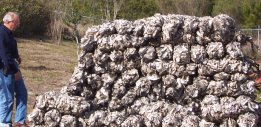 Shell bagging events may be supervised by SCDNR staff but volunteer groups are encouraged to designate a coordinator who can be trained by SCDNR to lead such activities. This is particularly desirable outside Charleston County since the entire SCDNR staff assigned to the SCORE program is based in Charleston.
Shell bagging events may be supervised by SCDNR staff but volunteer groups are encouraged to designate a coordinator who can be trained by SCDNR to lead such activities. This is particularly desirable outside Charleston County since the entire SCDNR staff assigned to the SCORE program is based in Charleston.
Shell to be used for bagging may be obtained from SCDNR or by local recycling efforts. Any local recycling efforts should be coordinated with SCDNR to ensure that the shell is properly aged before use.
Reef Construction
Reefs are constructed during the summer months because that is when young, free-swimming oysters are available for recruitment to appropriate substrates. Reef construction consists of moving prefilled shell bags from a stockpile or staging area to the intertidal site where the reefs will be located. Since all reefs are built on intertidal sites, construction can only occur at low tide. The actual process is different for each site and may involve use of small boats, trucks or trailers, wheelbarrows, or human chains to move the bags.
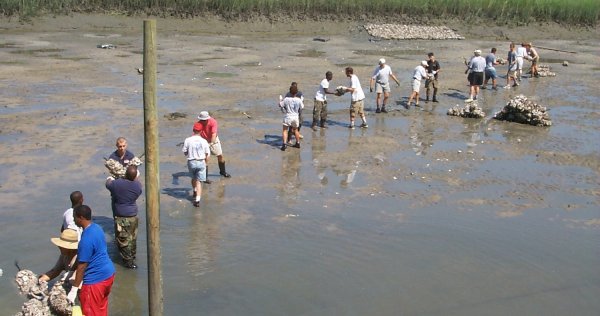
Reef construction must be supervised by SCDNR staff. Construction dates are routinely announced on the calendar on this web site and via an e-mail alert list. Contact the SCORE Team at SCDNR if you would like to receive emails about this project. Volunteers are always needed to assist in building oyster habitats!